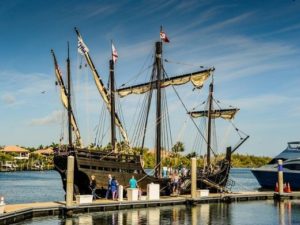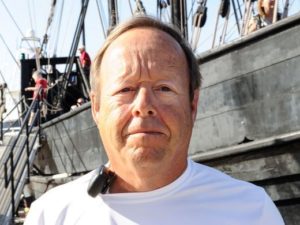BY: Lori Griffith, April 6th
 Gracing the docks of Harbourside Place in Jupiter the week of March 24 were replicas of the Niña and Pinta, two of three ships in Spanish explorer Christopher Columbus’ historic fleet.
Gracing the docks of Harbourside Place in Jupiter the week of March 24 were replicas of the Niña and Pinta, two of three ships in Spanish explorer Christopher Columbus’ historic fleet.
The Niña is a replica of the ship on which Columbus sailed across the Atlantic during his three voyages of discovery to the new world beginning in 1492.
Thousands of Jupiter visitors toured the ships, taking a step back in history and being regaled with tales by the friendly and knowledgeable crew members.
Don Pierce began crewing on the Pinta in Fort Myers earlier this year and has plans of traveling with the ship for a few years. He explained to visitors how the name “poop deck” came to be.
A very religious Spanish people …
“The name originated by the very religious Spanish people. Prior to sailing, a priest would board, blessing the ship and crew. He had religious puppets mounted on the masts and that way the crew would have religious thoughts as they were crossing. Puppet in Portuguese is spelled ‘popu’ and that’s where the name came from.”
Pierce added the ships are black and that is from pine tar that is very sticky, tacky and got on everything including the lines, deck, etc. Columbus used the substance for rigging and decking. A bit of trivia, Pierce added: “The North Carolina college football team is called Tar Heels because sailors, after walking on decks with pine tar, would leave footprints everywhere.”
Captain of the Niña
Captaining the Niña was Steve Sanger.
His father had the Niña and Pinta built in Brazil, where it took 20 men to construct each of the ships. Brazilians still use 15th century trade tools, and no electricity was used in the construction of the ships. The Niña has been traveling since 1992 and the Pinta came into service in 2005.
Sanger explained, “Back in the day, on the second voyage, Columbus brought 17 ships with him, the Niña being the flagship. The fleet ran into a hurricane, which took out every single ship except for the Niña. Columbus picked up around 120 survivors from the waters and packed them on the Niña, which normally held 20 to 30 crew members.
“It’s insane to imagine that many people crammed into a ship 65-foot long by18-foot wide. Only about half of them made it back alive to Spain.”
And the Santa Maria?
Asked why the Santa Maria isn’t part of their fleet, Sanger said that while the “Niña and Pinta are Portugese caravel ships, typical of trading vessels at the time, the Santa Maria was much more a cargo ship.
“She had a deeper belly and would need 12 to 14 feet of water when fully loaded and a lot of the places we travel around the country couldn’t accommodate her. But on the original voyage, Columbus was on the Santa Maria when she wrecked on a reef off Haiti on Christmas Eve 1492. He boarded the Niña for the voyage back to Spain while 40 men from the Santa Maria remained on shore to build a settlement. When Columbus returned years later to rescue the men, there was no trace of the men,” he said.
When the Niña and Pinta later departed Jupiter, the Niña crew was in possession of a very special piece of cargo entrusted to Sanger from Harbourside Place dockmaster, Capt. Jay Fortier.
Fortier, a sea captain like his father before him, Capt. Jacques Fortier, recently came into possession of a replica chart depicting the path of the Niña, Pinta and Santa Maria along the Florida coastline, while going through is father’s possessions.
Jacques Fortier died on April 24, 2015. And Jay Fortier, wanting to honor his father, asked the captain of the Niña if he would take the chart with him on board, “allowing my dad to complete his journey because he never had the chance to.” Sanger agreed.
The elder Fortier had taught his son the ways of the sea as a teenager, beginning in Sebastian where they had a home in Mathers Cove. However, an accident at sea 26 years ago ended Jacques Fortier’s career, yet he could still live vicariously through the sea travels of his son.
“My dad was thrown violently at sea and landed on his back on a glass table. His health went downhill from there, and he was in my care until the end, when he died at home with me,” Jay Fortier said. “So, I figured passing the chart on to the Niña would be good because he always relished the fact that I took ships to Japan and Korea and have been around the world.”
“He loved hearing my stories. My dad always wanted to go to Asia but never made it, so I thought this would be a good idea to give dad his last journey. It’s apparent he’s had this chart for a long time. It’s a replica of the original, but if you look at it, you wouldn’t know. The edges are all frayed and the paper is aged. I don’t even know where he got it. My brother is in medicine and works for the North Atlantic Treaty Organization, and didn’t make it home in time for Dad’s passing. So I wanted to give him a little closure, too.
“Our dad had a huge library — and not paperbacks, he had ‘Mein Kampf,’ and volumes of Aristotle, Plato and Archimedes. I found the chart while going through his vast library and embossed it with his personal library stamp.”
Sea captain career ends
Ironically, Jay Fortier’s career as a sea captain also ended as the result of an accident — however it was in a car, not at sea.
While captaining Steve Tendridge’s 116-foot yacht, Le Bon Jou Jou, off the coast of St. Maarten, Fortier recalled that he intended to ask for use of the yacht to personally vacation on, and as he leaned in and said, “Boss, I need to ask a favor.” Tendridge immediately informed Fortier that indeed he was getting a substantial raise. Shocked and grateful, Fortier. thanked him and told him that he was inquiring about getting vacation time on the yacht — and not a raise.
Fortier said he had always been a captain on the yacht and had never vacationed aboard so was looking forward to a luxury vacation.
Later, while back in Jupiter, driving a vehicle across the Indiantown Bridge, Fortier signaled to move into the right-hand lane, he said. And as he pulled out from behind a large truck, he slammed into a car parked in the right lane without any flashers, he recalled. Fortier broke his neck in three places, ultimately ending his career at sea.
After a lengthy rehabilitation, the offer to be dockmaster at Harbourside Place presented itself. According to Fortier, “This is the best move I’ve ever made.”
The journey …
Meeting with the captains and crew of the Niña and Pinta, it struck Fortier that inquiring if they would take his father’s chart with them when they departed just felt right and would give him and his brother closure.
The chart he entrusted to Sanger would journey next to to Vero Beach, St. Marys, Georgia; Charleston, South Carolina; Wilmington, North Carolina; north to Newport, Rhode Island; up the Hudson River and on to the Erie Canal.
The twin ships were scheduled to then travel the Great Lakes during the summer and filter down through Chicago, the Mississippi River, the mid-western river system — and in the fall finish back where they started, in the Gulf of Mexico.

